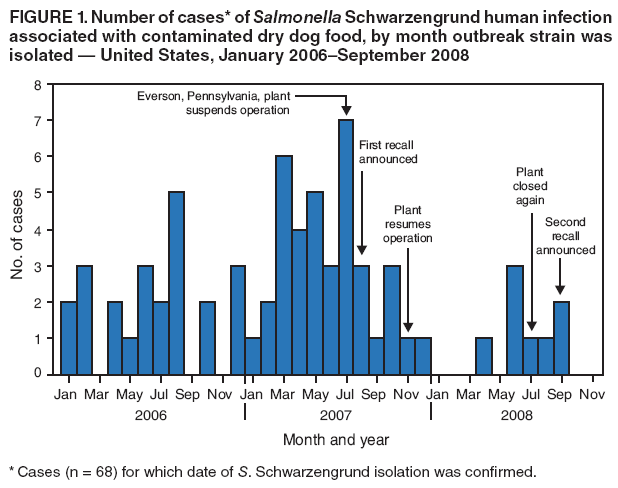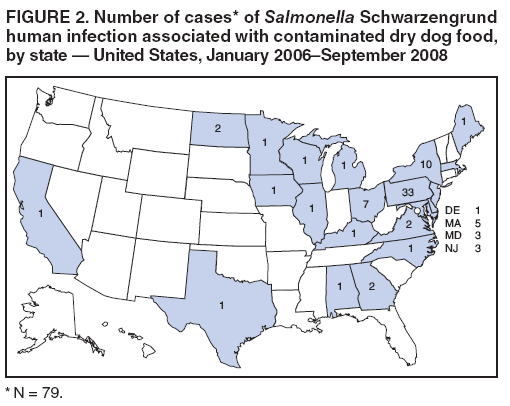 |
|
|
|
|
|
|
| ||||||||||
|
|
|
|
|
|
|
||||
| ||||||||||
|
|
| Weekly |
| November 7, 2008 / 57(44);1200-1202 |
|
|
|
Persons using assistive technology might not be able to fully access information in this file. For assistance, please send e-mail to: mmwrq@cdc.gov. Type 508 Accommodation and the title of the report in the subject line of e-mail. Update: Recall of Dry Dog and Cat Food Products Associated with Human Salmonella Schwarzengrund Infections --- United States, 2008On May 16, 2008, CDC reported on a 2006--2007 multistate outbreak of infection with Salmonella enterica serotype Schwarzengrund that was associated with dry dog food (1). At the time of that report, a total of 70 cases had been reported from 19 states, with the last case identified on October 1, 2007. Subsequently, an additional case was identified on December 29, 2007. Epidemiologic and environmental investigations have suggested the source of the outbreak was dry pet food produced by one manufacturer, Mars Petcare US. This report updates the previous CDC report, provides additional epidemiologic findings, and describes additional actions taken by public health agencies and the manufacturer. In 2008, eight more cases have been reported, bringing the total number of cases in the outbreak to 79. On September 12, 2008, the company announced a nationwide voluntary recall of all dry dog and cat food products produced during a 5-month period at one Pennsylvania plant.* Dry pet food has a 1-year shelf life. Contaminated products identified in recalls might still be in the homes of purchasers and could cause illness. Persons who have these products should not use them to feed their pets but should discard them or return them to the store. During 2006--2007, CDC, the Food and Drug Administration (FDA), and multiple state health departments investigated reports to PulseNet† of persons infected with a strain of S. Schwarzengrund with an indistinguishable pulsed-field gel electrophoresis (PFGE) pattern.§ A case was defined as a laboratory-confirmed infection with the outbreak strain of S. Schwarzengrund in a person residing in the United States who either had symptoms beginning on or after January 1, 2006, or (if the symptom onset date was unknown) had S. Schwarzengrund isolated from a specimen on or after January 1, 2006. Investigators initially identified 70 cases, mostly in children. As a result of these findings, on August 21, 2007, Mars Petcare US (referred to as manufacturer A in the May 16, 2008 report) announced voluntary recalls of selected sized bags of two brands of dry dog food, both manufactured by the company at its plant in Everson, Pennsylvania. The recall was based on microbiologic testing by FDA, which found unopened bags of the two brands contaminated with the outbreak strain. Other brands of dry dog and cat food produced at the same facility were not included in that recall. The Everson, Pennsylvania, facility ceased operations during July--November 2007 to enable cleaning, disinfection, and renovation, and resumed normal operations in mid-November 2007. Despite the 2007 recall, the outbreak strain of S.Schwarzen-grund was isolated from eight more ill persons during January--October 2008 (Figure 1), bringing the total number of cases to 79 in 21 states (Figure 2). The ill persons were residents of Pennsylvania (three), Georgia (two), New York (two), and Texas (one). The last reported specimen collection date was September 18, 2008. The only connection between the ill persons was infection with the outbreak strain; they shared no household or family contacts. Among the eight ill persons, five were female. Among the seven whose age was available, the median age was 8 months (range: 4 months--39 years); six persons were aged <2 years. Of five ill persons for whom clinical information was available, all five had visited a health-care professional, two had bloody diarrhea (no information on symptoms was available for the other three), and one had been hospitalized. No deaths were reported. Of six households with pet ownership known, all six had pets (i.e., dogs, cats, or both), but no illness was reported in any pet. Pets in three households were being fed a brand of dry pet food known to be produced at the Everson plant. Investigators collected seven dog stool specimens and two samples of dry dog food from the homes of two Pennsylvania patients. None of the stool specimens or dog food samples tested positive for Salmonella. Bag lot numbers and "best by" dates could not be examined in these households because the dog food had been poured into plastic containers and the bags discarded. Consequently, investigators could not be certain that the dog food from the two households had been produced at the Everson plant, and, if so, whether the dog food had been produced after the plant was reopened in November 2007 or earlier. After additional outbreak-linked illnesses were identified in 2008, FDA conducted another investigation. In August 2008, FDA found the outbreak strain of S. Schwarzengrund in multiple brands of finished product at the plant, prompting another recall of products by Mars Petcare US. On September 12, the company announced a nationwide voluntary recall of all dry dog and cat food products produced at the Everson plant from February 18 to July 29, 2008, when production again was suspended at the plant. In addition, Mars Petcare US has taken steps to ensure that recalled products are no longer on store shelves. On October 1, the company announced that the Everson plant would be closed permanently. The FDA investigation is continuing. Reported by: M Deasy, M Moll, MD, V Urdaneta, MD, S Ostroff, MD, Pennsylvania Dept of Health. E Villamil, MPH, P Smith, MD, New York State Dept of Health. PulseNet; C Barton Behravesh, DVM, IT Williams, PhD, Div of Foodborne, Bacterial, and Mycotic Diseases, National Center for Zoonotic, Vector-Borne, and Enteric Diseases, CDC. Editorial Note:This outbreak of human Salmonella Schwarzengrund infections has continued over a 3-year period, likely because of continued contamination in the Everson, Pennsylvania, pet food production facility. S. Schwarzengrund is a rare serotype of Salmonella. Although the outbreak PFGE pattern is the most common S. Schwarzengrund PFGE pattern in the PulseNet database, isolates with that pattern made up only 20 (4%) of the 498 S. Schwarzengrund isolates from humans submitted to PulseNet during 1999--2005, suggesting that the illnesses described in this report resulted from a common source. Considering the wide distribution of these products and the relatively small number of cases, the attack rate for this outbreak appears to be low. However, only an estimated 3% of all Salmonella infections in the United States are laboratory confirmed and reported to surveillance systems (2). A low attack rate supports the hypothesis that infection might have resulted from practices in a limited number of households that brought humans into contact with the contaminated pet food and led to amplification of the organisms (e.g., cross-contamination in the kitchens or irregular cleaning of pet food bowls that might promote bacteria growth). In addition, the strain might primarily affect persons (e.g., young children) who are more susceptible to lower infective doses. This outbreak is the first documented outbreak to associate human Salmonella infections with contaminated dry dog food and to trace human illness to a contaminated pet food plant. The original source of contamination and mechanisms for continued contamination in the Everson plant over a 3-year period are unknown. The absence of cases during January--March 2008 suggests that cleaning and disinfection of the plant might have had some effect. FDA is working with Mars Petcare US to better understand this problem. Since 2006, at least 13 recall announcements involving 135 pet products (e.g., dry dog food and cat food, pet treats, raw diets, and pet supplements) have been issued because of Salmonella contamination.¶ These recalls have resulted from contamination with multiple serotypes of Salmonella and have been associated with multiple pet food manufacturing plants in the United States. Pet products typically are recalled after product testing indicates contamination with Salmonella. To date, no human illness has been associated with these other pet food recalls. Although the last reported case in this outbreak was tested on September 18, 2008, additional cases might occur. The September 2008 recall involved approximately 23,109 tons of dry pet foods, representing 105 brands. However, dry pet food has a 1-year shelf life, and contaminated product might still be in the homes of purchasers and could produce illness. State and local health departments that identify ill persons with the outbreak strain should query ill persons or their caregivers to find out about pet-related exposures, including brands of dry pet food used in the home. When possible, pet stool specimens and samples of dry pet food should be collected and submitted for laboratory testing. Hypothesis-generating interviews for enteric infections should routinely include questions on contact with pets and other animals, pet food, pet treats, and pet supplements. Consumers and health departments should be aware that all dry pet food, pet treats (3), and pet supplements (4) might be contaminated with pathogens such as Salmonella, and consumers should use precautions with all brands of dry pet food, treats, and supplements. In contrast, canned pet food is unlikely to be contaminated with such pathogens because the manufacturing process should eliminate bacterial contamination. To prevent Salmonella infections, persons should wash their hands for at least 20 seconds with warm water and soap immediately after handling dry pet foods, pet treats, and pet supplements, and especially before preparing and eating food for humans. Infants should be kept away from pet feeding areas. Children aged <5 years should not be allowed to touch or eat dry pet food, treats, or supplements. In addition to transmission of Salmonella from contact with dry pet food, humans can acquire Salmonella infection from contact with the feces of animals that acquired Salmonella infection from contaminated dry pet food or other sources. Effective hand washing after handling pets and animal feces will prevent such infections. Persons who suspect that contact with dry pet food or pets has caused illness should consult their health-care providers. Additional information on the transmission of Salmonella from pets to humans is available at http://www.cdc.gov/healthypets/diseases/salmonellosis.htm. References
* The list of recalled products is available at http://petcare.mars.com/othernewsreleases.html. † The national molecular subtyping network for foodborne disease surveillance. § XbaI pattern JM6X01.0015. ¶ Available at http://www.accessdata.fda.gov/scripts/petfoodrecall. Figure 1  Return to top. Figure 2  Return to top.
All MMWR HTML versions of articles are electronic conversions from typeset documents. This conversion might result in character translation or format errors in the HTML version. Users are referred to the electronic PDF version (http://www.cdc.gov/mmwr) and/or the original MMWR paper copy for printable versions of official text, figures, and tables. An original paper copy of this issue can be obtained from the Superintendent of Documents, U.S. Government Printing Office (GPO), Washington, DC 20402-9371; telephone: (202) 512-1800. Contact GPO for current prices. **Questions or messages regarding errors in formatting should be addressed to mmwrq@cdc.gov.Date last reviewed: 11/6/2008 |
|||||||||
|